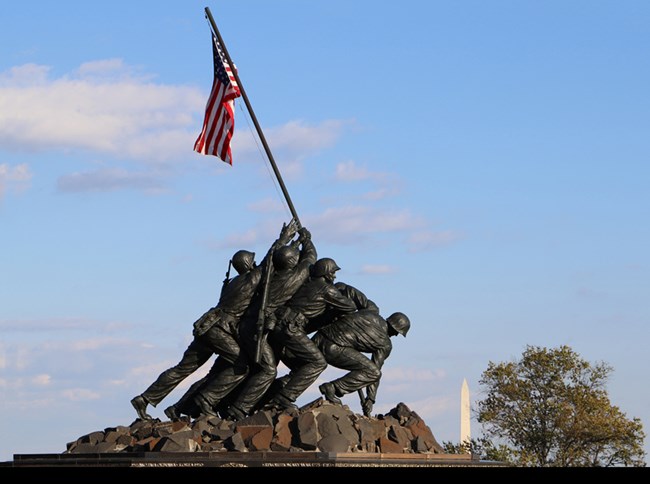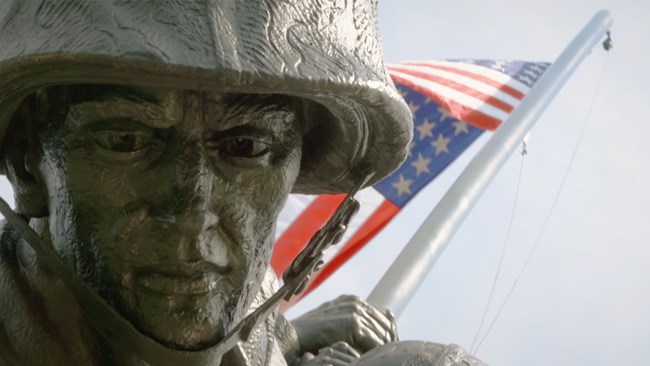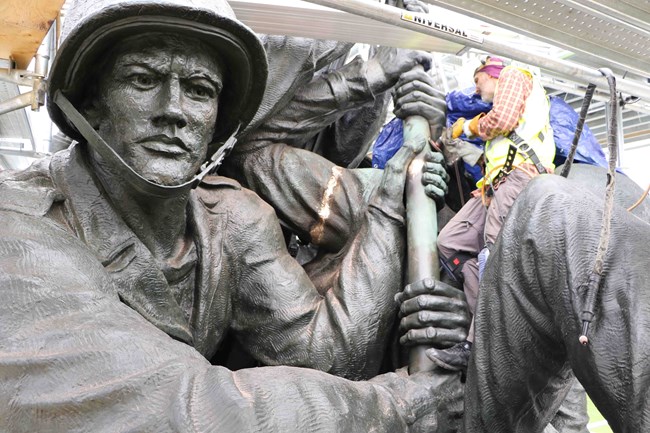|
"In honor and in memory of the men of the United States Marine Corps who have given their lives to their country since November 10, 1775." The United States Marine Corps War Memorial represents this nation's gratitude to Marines and those who have fought beside them. While the statue depicts one of the most famous incidents of World War II, the memorial is dedicated to all Marines who have given their lives in defense of the United States since 1775. 
Visit the Marine Corps War Memorial The Picture behind the Statue The tiny island of Iwo Jima lies 660 miles south of Tokyo. Mount Suribachi, an extinct volcano that forms the narrow southern tip of the island, rises 550 feet to dominate the ocean around it. US troops had recaptured most of the other islands in the Pacific Ocean that the Japanese had taken in 1941 and 1942. In 1945 Iwo Jima became a primary objective in American plans to bring the Pacific campaign to a successful conclusion. On the morning of February 19, 1945, the 4th and 5th Marine Divisions invaded Iwo Jima after an ineffective 72-hour bombardment. The 28th Regiment of the 5th Division, was ordered to capture Mount Suribachi. They reached the base of the mountain on the afternoon of February 21 and, by nightfall the next day, had almost completely surrounded it. On the morning of February 23, Marines of Company E, 2nd Battalion, started the tortuous climb up the rough terrain to the top. At about 10:30 am men all over the island were thrilled by the sight of a small American flag flying from atop Mount Suribachi. That afternoon, when the slopes were clear of enemy resistance, a second, larger flag was raised in the same location. Making of a Memorial Joe Rosenthal of the Associated Press caught the afternoon flag-raising in an iconic photograph that eventually won a Pulitzer Prize. Sculptor Felix W. de Weldon, then on duty with the US Navy, was so moved by the image that he constructed first a scale model and then a life-size model of it. Rene Gagnon, Ira Hayes, and John Bradley posed for the sculptor as he modeled their faces in clay. These three men were believed to be the survivors of the famous flag raising (the others were killed on Iwo Jima). All available pictures and physical statistics of the three who had given their lives were collected and then used in the modeling of their faces. President Dwight D. Eisenhower dedicated the memorial in a ceremony on November 10, 1954, the 179th anniversary of the U.S. Marine Corps. Memorial Statistics Thirty-two foot high figures are shown raising a 60-foot bronze flagpole. The flag flies 24 hours a day, 365 days a year by presidential proclamation. The figures in the statue occupy the same positions as they were identified at the time in Rosenthal's historic photograph. Ira Hayes is the figure farthest from the flagpole with both hands reaching up. Harold Schultz is in front of Hayes, to the right. Michael Strank is in front of Hayes, to the left. Franklin Sousely is in front of Schultz. Harold Keller is in front of Strank. Harlon Block is at the foot of the flagpole. The M-l rifle and the carbine carried by two of the figures are 16 and 12 feet long, respectively. The canteen would hold 32 quarts of water. The figures stand on a rock slope above a granite base. The entire memorial is about 78 feet tall. Granite for the base came from Sweden. The names and dates of every principal Marine Corps engagement since the founding of the Corps form a gold ring around the base. The entire cost of the statue ($850,000) was donated by US Marines, friends of the Marine Corps, and members of the Naval Service. No public funds were used for this memorial. 
NPS Image 
Learn About the Recent Rehabilitation of the US Marine Corps War MemorialVisit our rehabilitation page to see information, photos and videos of the recent 2016 - 2020 rehabilitation project that occurred at the US Marine Corps War Memorial. |
Last updated: May 1, 2023
